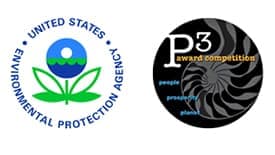UNC Charlotte team creates solar-responsive design material for national competition

A team of six UNC Charlotte students, led by faculty members Mona Azarbayjani from the School of Architecture and Michael Walter from the Department of Chemistry, will compete in the “People, Prosperity and Planet (P3) Student Design Competition for Sustainability” held by the U.S. Environmental Protection Agency in Alexandria, Va., April 11-12.
In fall 2014, the UNC Charlotte team received a $15,000 grant to develop a project to address an environmental challenge found in the developed or developing world. The team will present its proposal in April to compete for a P3 award for grant funding up to $75,000 to advance the project design, implement it in the field and move it to the marketplace. Comprised of undergraduate and graduate students, the UNC Charlotte team includes three individuals from the School of Architecture, two from the Department of Chemistry and one from the Department of Physics and Optical Science.
For the project, the UNC Charlotte team has developed a solar-responsive design material that will transform windows into environmentally responsive surfaces that can simultaneously provide shade and convert sunlight into usable electric energy.
The unique nature of the material reacts to the intensity of the sunlight striking the window. Excess solar energy is then converted to electricity instead of heating the interior of a building. This material can be incorporated as a very thin layer on a glass surface, which can be used in different parts of the building’s exterior, such as skylights, façades, windows or curtain walls.
In October, the UNC Charlotte team received a commendation from Gov. Pat McCrory. He noted, “Innovation and cutting-edge projects like these are the best of what North Carolina is about and will undoubtedly impact our environment and future in a positive way.”
The UNC Charlotte team’s project could revolutionize the use of glass in homes, buildings and even automobiles.
Micro-sized, wire-shaped solar cells are embedded in a thin film of clear, heat-responsive plastic material. The film can be put on the surface of an existing window or between panes when windows are manufactured. The plastic absorbs the heat that the sunlight produces and reacts by expanding, which causes the nearly invisible wires to bend and the window to become tinted. This allows the solar cells to absorb more visible light, increasing the efficiency of the window as a solar panel, which can help feed the building’s energy needs. Once the window cools, the plastic and wires will return to their original positions.
The Chemistry Department’s Walter stated the project’s “purpose is to lower the energy consumption of the building and to have it become more sustainable. It has been so exciting to be in chemistry and sort of engineering and working with someone who’s in building engineering and architecture. The language is all different from what we talk about, and it’s exciting to collaborate.”
In addition to the initial grant from the EPA, the project has been funded by University grants from the Energy Production and Infrastructure Center (EPIC), the Department of Chemistry, and the School of Architecture.
Since 2004, the P3 Program has provided funding to student teams in all 50 states and Puerto Rico, committing more than $10 million to cutting-edge, sustainable projects designed by university students. Nationally the grants were awarded to 42 teams of college and university students this year.